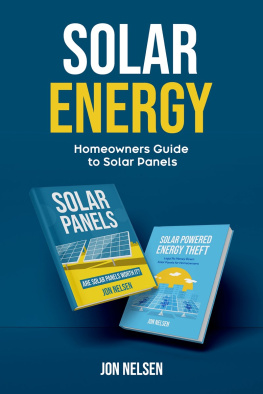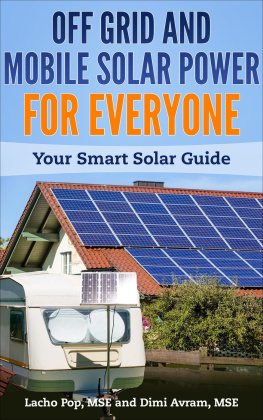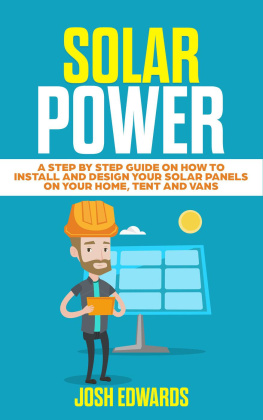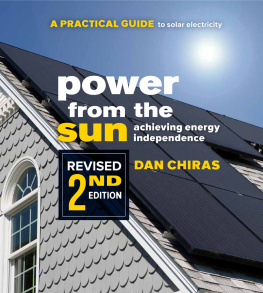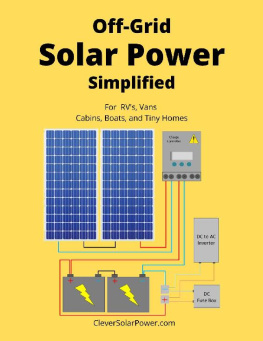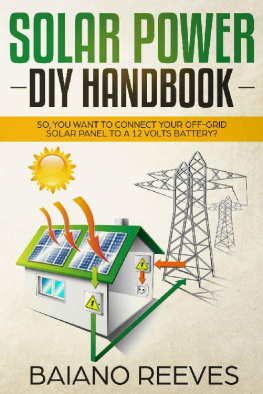Will Smart - Solar Power for Beginners: The DIY Guide to Easily Install a Solar Power System in Your Home
Here you can read online Will Smart - Solar Power for Beginners: The DIY Guide to Easily Install a Solar Power System in Your Home full text of the book (entire story) in english for free. Download pdf and epub, get meaning, cover and reviews about this ebook. year: 2020, genre: Home and family. Description of the work, (preface) as well as reviews are available. Best literature library LitArk.com created for fans of good reading and offers a wide selection of genres:
Romance novel
Science fiction
Adventure
Detective
Science
History
Home and family
Prose
Art
Politics
Computer
Non-fiction
Religion
Business
Children
Humor
Choose a favorite category and find really read worthwhile books. Enjoy immersion in the world of imagination, feel the emotions of the characters or learn something new for yourself, make an fascinating discovery.

- Book:Solar Power for Beginners: The DIY Guide to Easily Install a Solar Power System in Your Home
- Author:
- Genre:
- Year:2020
- Rating:5 / 5
- Favourites:Add to favourites
- Your mark:
Solar Power for Beginners: The DIY Guide to Easily Install a Solar Power System in Your Home: summary, description and annotation
We offer to read an annotation, description, summary or preface (depends on what the author of the book "Solar Power for Beginners: The DIY Guide to Easily Install a Solar Power System in Your Home" wrote himself). If you haven't found the necessary information about the book — write in the comments, we will try to find it.
Are you interested to explore the potential of solar energy and contribute to making our planet greener?Do you want to generate your own power, pay no electricity bill, and make money by selling power to the grid?
If you answered yes to any of these questions, keep reading.
Solar power is here to stay. It develops no waste, does not create pollution, and does not require tremendous infrastructure investment. Once you set it up, you do not need to pay your electric bill. It is also considered a socially responsible way to generate energy and is good for your country. Unfortunately, not many people are aware of this fact.
The ideal scenario toward self-sufficiency is to produce your own energy using the solar system. You can install it by yourself at your own home and be worry-free because you wont receive any power bill. In fact, you can link your system to the grid and sell any excess power that you dont use, back to the grid. In this way, you can get paid every month. This book will guide you into how you can make the world a place to live in and get paid for doing so even if you dont have any experience in installing a DIY solar system.
Heres a summary of this amazing book, and what else youll learn:
- What is solar power, how does PV technology, and why is it a better option for generating your own power
- What do you need to know as a beginner before you install a solar power generation system at your home
- How can you install a solar system for your home with this step-by-step guide
- What are the benefits of installing your own power generation system and how can you make money from it in the long run>
- What are the considerations that you need to make if you use solar power predominantly for heating or cooling
- What you need to know before installing solar systems to support inverter-based air conditioning systems
and much more!
Solar power systems have a great many benefits and the technology is constantly being improved, its prices are being reduced and the social and economic payoffs are significant. In other words, now is the best time to install a solar panel system which is a gift that keeps on giving. This beginners guide is your indispensable resource in enabling you to capitalize on this opportunity and live better.
So, scroll up and click the Buy now with 1-click button and lets get started!Will Smart: author's other books
Who wrote Solar Power for Beginners: The DIY Guide to Easily Install a Solar Power System in Your Home? Find out the surname, the name of the author of the book and a list of all author's works by series.

